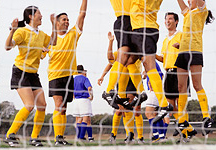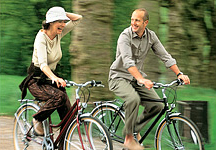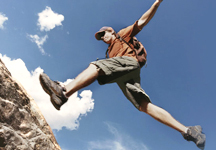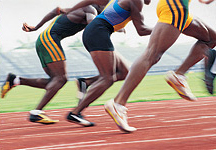



Athletic Foot Care
Whether you are a professional athlete or play sports just for fun, the demands made on your feet and lower limbs can lead to a range of injuries, including blisters, sprained ankles, torn ligaments, shin splints (leg pain), knee pain, low back pain and other joint or muscle problems. Added to these are common complaints such as corns, calluses and Athlete's foot. Your running style, poor footwear and even minor limb length differences can also contribute to injury.
Here are some tips for athletic foot care:
- Wash your feet every day, and dry thoroughly.
- Wear only good-quality, well-fitting cotton socks.
- Always use the correct shoe for each sport and surface.
- Get in shape. Being overweight or out of shape places added stress on the feet. Condition yourself gradually with stretching exercises for 15-20 minutes before starting and after any activity ("warm-up" and "warm-down").
- Wear correct shoes. Footwear should be given the same consideration as any other piece of sporting equipment. Sports shoes should protect as much as possible, be durable, and should be right for the sport and surface. If running, the shoe should have adequate cushioning in the mid-sole and a flared heel for stability.
Sports Injuries
Martial arts and kick boxing
A variety of injuries can occur as a result of martial arts and kick boxing. These include plantar fasciitis, Achilles tendonitis, sesamoiditis, and ankle sprains. Stretching is recommended for a minimum of 15 minutes before performing any kicking or punching.
Aerobics
Proper shoes are crucial to successful, injury-free aerobics. Shoes should provide sufficient cushioning and shock absorption to compensate for pressure on the foot many times greater than found in walking. They must also have good medial-lateral stability. Impact forces from aerobics can reach up to six times the force of gravity, which is transmitted to each of the 26 bones in the foot.
Team Sports
Activities such as football, basketball, soccer, field hockey and lacrosse often lead to ankle and big toe joint injuries as a result of play on artificial surfaces.
Turf toe
Big toe injuries also called "turf toe," often result from hyperextension of the big toe joint as the heel is raised off the ground. An external force is placed on the great toe and the soft tissue structures that support the big toe on the top are torn or ruptured.
Symptoms include pain, tenderness and swelling of the toe joint. Often there is a sudden acute onset of pain during push-off phase of running. Usually, the pain is not enough to keep the athlete from physical activities or finishing a game. This causes further injury to the big toe and will dramatically increase the healing time.
Treatment includes rest, ice, compression, and equipment modification or change. Non-steroidal anti-inflammatory drugs (NSAIDs) may be used for relief of minor pain as well as to decrease the inflammation of the injury. Consult your physician before taking any medication.